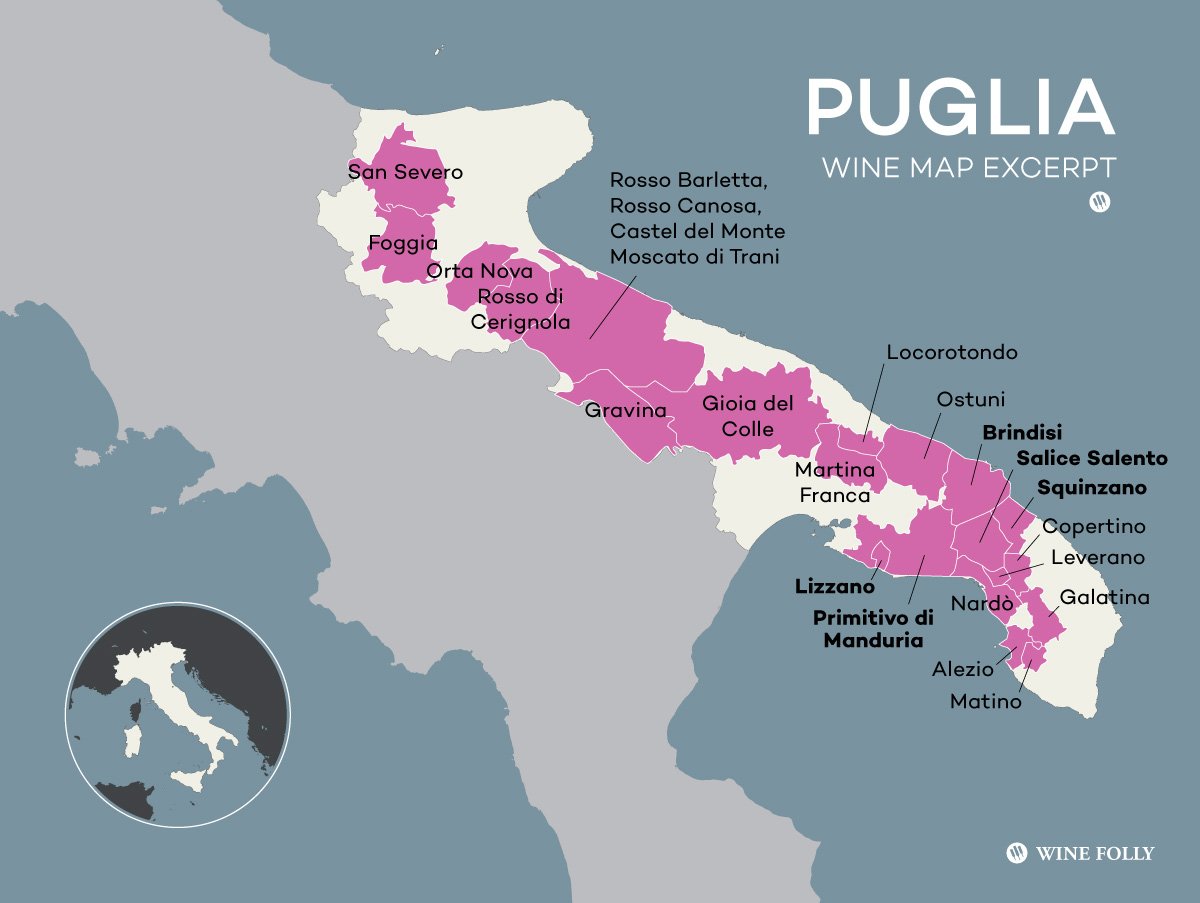America’s Grape?
Let me begin by saying I’m sorry. I know…I have been seriously delinquent in posting. My day job has turned into a day, night, weekend sort of thing. Very busy but very rewarding. Unfortunately, the blog frequency has suffered accordingly. I’ve missed you guys!
Ok, apologies made. So where to? It’s November and I woke up to a dusting of white on the lawn. Ugh. How about something to kick-start the holiday season? Something warming and just as American as Thanksgiving…Zinfandel!
But hold on. You know we’re all about learning here at The Wine MD. Well, our lesson today begins by dispelling a once widely held belief that Zinfandel is “America’s grape”.
Turns out Zin is an immigrant too. Viticulturists from UC Davis discovered that Primitivo, the red grape predominant in the region of Puglia (the heel of Italy’s boot), is genetically identical to Zinfandel. See below from our friends at Wine Folly..
But it didn’t stop there. Primitivo’s origins trace further back to Croatia. A little known and almost extinct varietal known as Crljenak Kastelanski (don’t ask me how to pronounce that one; let’s just call it “CK”) was found to have the same DNA fingerprint as Primitivo and Zinfandel. With Croatia just across the Adriatic, it’s easy to see how it ended up in Italy.
CK made its way to the US in the 1800s from Austria, who controlled Croatia back then. Armed with a new name (a derivation of a different Austrian grape), Zinfandel thrived in California beginning with the gold rush. At one point it was California’s most planted varietal. Although no longer #1, Zin is still in the top 4.
Zin 101
Zinfandel is a bold wine. It is fruit-forward, usually showing a variety of rich, dark fruit characteristics, which often are characterized as “jammy”. It also has a spicy quality, which can run the gamut from black pepper to cinnamon.
Zin is a thin-skinned grape, which means it ripens early. It also grows in big bunches, which often require a more labor-intensive process to ensure that rot does not set in.
Zinfandel grapes are high in sugar, which means they can often (but not always; look at your label carefully) be higher in alcohol. 15%+ ABV is not uncommon.
Our Wine: Frog’s Leap 2019 Zinfandel Napa Valley.
Low-to-mid $30s retail.
This label may be familiar to many of you. Frog’s Leap is another one of those wonderful family stories we love here at The Wine MD. They have been making great wine in Napa Valley for 40 years.
A little backstory is definitely in order…
In the 1970s, college student John Williams travels to Napa and meets Larry Turley, a young ER physician (and now proprietor of Turley Wine Cellars). The two become friends and start Frog’s Leap Winery, named after the former frog farm on Turley’s property.
Williams’ sense of humor was evident from the start: the Frog’s Leap motto is “Time’s fun when you’re having flies”.
The first wine, a 1981 Sauvignon Blanc, attracts immediate recognition. The New York Times writes about it - “Frog’s Leap: A Prince of a Wine”.
In the ‘80s, Frog’s Leap becomes a pioneer in organic grape growing: totally dry-farmed, biodynamic vineyards. Williams is a big believer in terroir: “we don’t make great wine; we grow it”.
Today, with home base in Rutherford and active participation by the Williams second generation, Frog’s Leap produces 65,000 cases of Sauvignon Blanc, Chardonnay, Merlot, Cabernet Sauvignon and of course, Zinfandel.
Tasting:
Before we begin, there are two things you should know. One, this bottling has 15% Petite Sirah in the blend. Loyal readers will remember this grape from the Stags’ Leap October 2021 post. Frog’s Leap favors adding one or two supporting grapes to their Zin such as Petite Sirah or Carignan. Two, the alcohol is a more manageable 14.5%, also a Frog’s Leap hallmark.
Check out the cork!
So what’ve we got? In the glass, the Zin is not as dark as you might expect. A beautiful medium garnet color. On the nose, very definitely black fruits - blackberry and black plum. There are also some gravel notes, which speak to the volcanic soils where these vines grow.
On the palate, you immediately pick up some red fruit flavors as well. The word that stands out for me is “fresh”. This wine is lively, with a little more elegance than you might expect. After a little while, some spice notes come through as well. Tannins are in check and acidity is moderate, but high enough to produce that freshness. The finish is noticeably long.
Food:
Just in time for Thanksgiving - Zinfandel to the rescue! You often hear that Thanksgiving can be a wine pairing challenge. This stems primarily from the main act - turkey. The reality is, with many ways to prepare a turkey, plus all the flavorful sides that go with it, Thanksgiving is pretty wine friendly.
I even chose Thanksgiving as the topic for my very first post 3 years ago! I’ll admit it’s a bit long, but there are some good ideas (focus on the varietal, not the specific wine).
Other American matches for Zin? It’s not that complicated. BBQ ribs, brisket, anything smoked or with a spicy rub or marinade. Also braised meats like short ribs.
As we now know, Zin isn’t just a Yank grape, its a globe-trotter. If you like North African & Middle Eastern food, Zin works. It also pairs well with Asian barbecue and Mexican Moles. And don’t forget fire-roasted or grilled vegetables.
The Bottom Line:
A very balanced wine. As time wore on and the wine had more air, it became even smoother and more integrated. Unlike some Zins you may have had in the past, the Frog’s Leap does not clobber you with fruit and alcohol. This one is a bit more more sophisticated.
I will close by saying that while Zinfandel does not rise to the level of “outside my comfort zone” like Riesling, I generally don’t seek it out. After this experience, maybe I will. And you should too.
Until next time.
Cheers!





